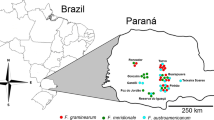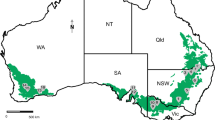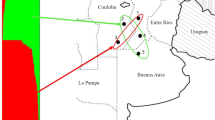Abstract
Microdochium majus and Microdochium nivale are two of fungal pathogens that cause Fusarium head blight (FHB) in wheat, and have also caused pink snow mold in eastern Hokkaido, Japan. With the aim of assessing levels of genetic variation and population structure, 172 isolates of these Microdochium species obtained from five populations of infected wheat seeds were first classified into each species using polymerase chain reaction (PCR) amplification with specific primers. In total 165 (95.9 % of all isolates) and seven isolates (six of Tokachi populations and one of Abashiri populations) were identified as M. majus and M. nivale, respectively, indicating that M. majus was predominant and the main causal pathogen of FHB in this area. Inter-simple sequence repeat (ISSR) analysis showed that the total genetic diversity was 0.023 when estimated by Nei’s gene diversity index within the five populations dominated by M. majus. An AMOVA analysis also showed that 86.74 % of the total genetic variation was within populations and 13.26 % among populations. These results indicated that little genetic differentiation occurred among the five populations of M. majus. Based on the unweighted pair group method of cluster analysis using the ISSR data, all isolates were identified as one of eight haplotypes in M. majus or six haplotypes in M. nivale, allowing the construction of a dendrogram with two clades corresponding to each species. There was no correlation between the clustering of isolates and their geographic distribution on the tree. These findings show that migration is likely playing an important role in the population biology of M. majus, providing some support for the prediction of epidemics of fungicide resistant strains within populations of the FHB pathogen.



Similar content being viewed by others
References
Bayraktar, H., Dolar, F. S., & Maden, S. (2008). Use of RAPD and ISSR markers in detection of genetic variation and population structure among Fusarium oxysporum f. sp. ciceris isolates on chickpea in Turkey. Journal of Phytopathology, 156, 146–154.
Bornet, B., & Branchard, M. (2001). Nonanchored inter simple sequence repeat (ISSR) markers: reproducible and specific tools for genome finger- printing. Plant Molecular Biology Reporter, 19, 209–215.
Chadha, S., & Gopalakrishna, T. (2007). Comparative assessment of REMAP and ISSR marker assays for genetic polymorphism studies in Magnaporthe grisea. Current Science, 93, 688–692.
Diamond, H., & Cooke, B. M. (1997). Host specialisation in Microdochium nivale on cereals. Cereal Research Communications, 25, 533–538.
Dinolfo, M. I., Stenglein, S. A., Moreno, M. V., Nicholson, P., Jennings, P., & Salerno, G. L. (2010). ISSR markers detect high genetic variation among Fusarium poae isolates from Argentina and England. European Journal of Plant Pathology, 127, 483–491.
Excoffier, L., & Lischer, H. E. L. (2010). Arlequin suite ver. 3.5: a new series of perform population genetics analyses under Linux and Windows. Molecular Ecology Resources, 10, 564–567.
Gerlach, W., & Nirenberg, H. (1982). The genus Fusarium – a pictorial atlas. Berlin Germany: Paul Verlag.
Glynn, N. C., Hare, M. C., Parry, D. W., & Edwards, S. G. (2005). Phylogenetic analysis of EF-1 alpha gene sequences from isolates of Microdochium nivale leads to elevation of varieties majus and nivale to species status. Mycological Research, 109, 872–880.
Godwin, I. D., Aitken, E. A., & Smith, L. W. (1997). Application of inter simple sequence repeat (ISSR) markers to plant genetics. Electrophoresis, 18, 1524–1528.
Grosch, R., & Schumann, K. (1993). Aggressivitätsverhalten von Microdochium nivale Samuels U. Hallett an futtergräsern. Archives of Phytopathology and Plant Protection, 28, 139–146.
Jewell, L. E., & Hsiang, T. (2013). Multigene differences between Microdochium nivale and Microdochium majus. Botany, 91, 99–106.
Kalisz, S., Hanzawa, F. M., Tonsor, S. J., Thiede, D. A., & Voigt, S. (1999). Ant-mediated seed dispersal alters pattern of relatedness in a population of Trillium grandiflorum. Ecology, 80, 2620–2634.
Lees, A. K., Nicholson, P., Rezanoor, H. N., & Parry, D. W. (1995). Analysis of variation within Microdochium nivale from wheat: evidence for a distinct sub-group. Mycological Research, 99, 103–109.
Mahuku, G. S., Hsiang, T., & Yang, L. (1998). Genetic diversity of Microdochium nivale isolates from turfgrass. Mycological Research, 102, 559–67.
Maurin, N., Rezanoor, H. N., Lamkadmi, Z., Some, A., & Nicholson, P. (1995). A comparison of biological, molecular and enzymatic markers to investigate variability within Microdochium nivale (Fries) Samuels and Hallett. Agronomie, 15, 39–47.
McDermott, J. M., & McDonald, B. A. (1993). Gene flow in plant patho-systems. Annual Review of Phytopathology, 31, 353–373.
McDonald, B. A., & Linde, C. (2002). The population genetics of plant pathogens and breeding strategies for durable resistance. Euphytica, 124, 163–180.
Menzies, J. G., Bakkeren, G., Matheson, F., Procunier, J. D., & Woods, S. (2003). Use of inter-simple sequence repeats and amplified fragment length polymorphisms to analyze genetic relationships among small grain-infecting species of Ustilago. Phytopathology, 93, 167–175.
Millar, C. S., & Colhoun, J. (1966). Fusarium diseases of cereals: IV. Observations of Fusarium nivale on wheat. Transactions of the British Mycological Society, 52, 57–66.
Nei, M. (1973). Analysis of gene diversity in subdivided populations. Proceedings of the National Academy of Sciences of the United States of America, 70, 3321–3323.
Nicholson, P., & Parry, D. W. (1996). Development and use of a PCR assay to detect Rhizoctonia cerealis the cause of sharp eye- spot in wheat. Plant Pathology, 45, 872–83.
Nicholson, P., Lees, A. K., Maurin, N., Parry, D. W., & Rezanoor, H. N. (1996). Development of a PCR assay to identify and quantify Microdochium nivale var. nivale and Microdochium nivale var. majus in wheat. Physiological and Molecular Plant Pathology, 48, 257–271.
Nielsen, L. K., Justesen, A. F., Jensen, J. D., & Jørgensen, L. N. (2013). Microdochium nivale and Microdochium majus in seed samples of Danish small grain cereals. Crop Protection, 43, 192–200.
Parry, D. W., Rezanoor, H. N., Pettitt, T. R., Hare, M. C., & Nicholson, P. (1993). Analysis of Microdochium nivale isolates from wheat in the UK during 1993. Annals of Applied Biology, 126, 449–455.
Saitoh, K., Togashi, K., Arie, T., & Teraoka, T. (2006). A simple method for a minipreparation of fungal DNA. Journal of General Plant Pathology, 72, 348–350.
Samuels, G. J., & Hallett, I. C. (1983). Microdochium stoveri and Monographella stoveri, new combinations for Fusarium stoveri and Micronectriella stoveri. Transactions of the British Mycological Society, 81, 473–483.
Simpson, D. R., Rezanoor, H. N., Parry, D. W., & Nicholson, P. (2002). Evidence for differential host preference in Microdochium nivale var. majus and Microdochium nivale var. nivale. Plant Pathology, 49, 261–268.
Stenglein, A. S., & Balatti, A. P. (2006). Genetic diversity of Phaeoisariopsis griseola in Argentina as revealed by pathogenetic and molecular markers. Physiological and Molecular Plant Pathology, 68, 158–167.
Tanaka, F., Saito, I., Miyajima, K., Tsuchiya, S., & Tsuboki, K. (1983). Occurrence of thiophanate-methyl tolerant isolates of Fusarium nivale (=Gerlachia nivalis), a causal fungus of snow mold of winter wheat, in Japan (Abstract in Japanese). Japanese Journal of Phytopathology, 49, 565–566.
Terami, F., & Kawakami, A. (2006). Distribution of two pink snow mold (Microdochium nivale) varieties in Hokkaido prefecture and diversity of their growth speed (Abstract in Japanese). Japanese Journal of Phytopathology, 72, 203.
Wollenweber, H. W., & Reinking, O. A. (1935). Die Fusarien, ihre Beschreibung. Berlin, Germany: Schadwirkung und Bekämfung. Paul Parey. 355 pp.
Yeh, F. C., Yang, R. C., & Boyle, T. (1999). POPGENE (Microsoft Windows-based freeware for population genetic analysis. Release 1.31). Edmonton: University of Alberta.
Yu, M. Y., Ma, B., Luo, X., Zheng, X., & Xiaoyan, L. Y. (2008). Molecular diversity of Auricularia polytricha revealed by inter-simple sequence repeat and sequence-related amplified polymorphism markers. Current Microbiology, 56, 240–245.
Zietkiewicz, E., Raflaski, A., & Labuda, D. (1994). Genome fingerprinting by simple sequence repeat (SSR)-anchored polymerase chain reaction amplification. Genomics, 20, 176–183.
Author information
Authors and Affiliations
Corresponding author
Rights and permissions
About this article
Cite this article
Hayashi, Y., Kozawa, T., Aiuchi, D. et al. Population genetic structure of Microdochium majus and Microdochium nivale associated with Fusarium head blight of wheat in Hokkaido, Japan. Eur J Plant Pathol 140, 787–795 (2014). https://doi.org/10.1007/s10658-014-0509-3
Accepted:
Published:
Issue Date:
DOI: https://doi.org/10.1007/s10658-014-0509-3




